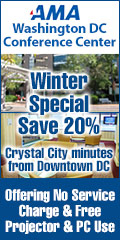
| Past Issues/Subscribe | Advertise | pmpi.org | February 2015 |
Choosing the RIGHT Vendor for Simultaneous Interpretation Equipment
What is Simultaneous Interpretation?
Simultaneous interpretation is facilitating the communication of speech from one language to another in real-time allowing presentations or conversations to flow naturally, without delay. The interpreted speech is usually heard by using a wireless receiver with earphone. This service might also be called conference interpretation, language interpretation or even simultaneous translation.
What type of equipment is required for Simultaneous Interpretation?
Interpretation Booths: Interpretation booths are used to provide sound insulation for the interpreters. They allow them to work in a quiet environment while blocking their voice from distracting the meeting attendees. Inside the booths, the interpreters will receive an audio feed of the floor channel (the current speaker in the meeting) and simultaneously interpret into another language.
Interpreter Consoles: The console is the central working station for interpreters allowing them to receive, transmit and control the audio. Two interpreters in a same language booth might share one console but individual microphones are always preferred.
Language Distribution: Language distribution provides the audio of the interpreted languages to the meeting attendees who require interpretation. For the majority of conferences, this is done wirelessly. In the world of interpretation there are two technologies used to wirelessly transmit language channels: Infrared (IR) or Radio Frequency (RF). Both IR and RF have their advantages and disadvantages, as follow:
Infrared (IR):
- No interference from cell phones, Wi-Fi and other RF devices.
- Secure and Confidential. Using IR prevents eavesdropping or confidential information to be heard outside of the meeting room.
- Audio quality: high fidelity, CD quality audio.
- More Channels: IR can accommodate up to 32 channels, while RF rarely goes beyond 8 channels.
Radio Frequency (RF):
- Easy to setup, the signal travels further and is non-directional.
- No need for emitter panels. IR requires a technician to setup emitters throughout the room for coverage.
- Multiple-room broadcast from one location: RF signals can travel through walls allowing listeners to be in different rooms.
Who provides interpretation equipment?
Conference Equipment Providers: Conference equipment providers tend to provide the best interpretation equipment and the best service. They are able to do this because their business is completely focused on simultaneous interpretation. Their staffs are specifically trained to work with interpretation equipment and interpreters to ensure the meeting runs smoothly. Since interpretation is a niche market, it's just as essential for the staff to be knowledgeable as it is for the equipment to be up-to-date.
Audiovisual Companies: The same companies that rent projection screens and sound systems will sometimes offer simultaneous interpretation equipment. Most A/V companies do not specialize in this service and own a minimal amount of equipment. Other A/V companies will offer the service and sub-rent the equipment from the aforementioned conference equipment providers.
Language Service Providers (LSP): LSPs are companies that offer mostly translation, but occasionally interpretation services as well. Some of the larger LSPs have an interpretation department. Usually they specialize in hiring and managing conference interpreters, but some companies provide the equipment as well. Those LSPs who do not own their own equipment will often source the service from conference equipment providers.
What should you look for in an interpretation equipment provider?
References: As a meeting planner, it is important to look at a vendor's references to ensure that they have experience in the type of event needed for your client. If your client is a large international law firm planning an annual meeting, ask prospecting vendors for a reference that meets those criteria.
Response Time: The time it takes a vendor to return calls, provide a quote and answer your questions, says a lot about a company's overall customer service and reflects on their service during an event.
Equipment: Beyond the general type of equipment offered, check with your prospective vendor the condition of the equipment used, the make and model and when the equipment was purchased. Since the meeting attendees will be in physical contact with this equipment (specifically the receivers) you want to make sure they are not using clunky, outdated equipment.
Possibly the most important part of choosing a vendor is how comfortable you feel with them. The criteria mentioned can help you determine what you can expect, but the comfort level that you have with a vendor can set your mind at ease.
Edited by Alexis La Broi, CMP, MBA, Media Vision, alexis@media-vision.com.
Reprinted with permission from Andrew Murphy, Conference Rental, andrew@conferencerental.com. Conference Rental is a nationwide conference equipment rental provider with offices in D.C., New York and San Francisco. Media Vision is a conference equipment seller with offices in the U.S., Canada, France, Belgium, Geneva and Scandinavia. |
MEETING PROFESSIONALS INTERNATIONAL
POTOMAC CHAPTER
Please visit our website at www.mpipotomac.org to learn more and register for all of our events,
as well as information about the resources we have to offer you.



